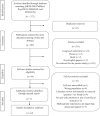Emotion Recognition in Adults With a History of Childhood Maltreatment: A Systematic Review
- PMID: 34238064
- PMCID: PMC9660286
- DOI: 10.1177/15248380211029403
Emotion Recognition in Adults With a History of Childhood Maltreatment: A Systematic Review
Abstract
Child maltreatment has many well-documented lasting effects on children. Among its consequences, it affects children's recognition of emotions. More and more studies are recognizing the lasting effect that a history of maltreatment can have on emotion recognition. A systematic literature review was conducted to better understand this relationship. The Preferred Reporting Items for Systematic Reviews and Meta-Analyses (PRISMA) protocol was used and four databases were searched, MEDLINE/PubMed, PsycINFO, EMBASE, and FRANCIS, using three cross-referenced key words: child abuse, emotion recognition, and adults. The search process identified 23 studies that met the inclusion criteria. The review highlights the wide variety of measures used to assess child maltreatment as well as the different protocols used to measure emotion recognition. The results indicate that adults with a history of childhood maltreatment show a differentiated reaction to happiness, anger, and fear. Happiness is less detected, whereas negative emotions are recognized more rapidly and at a lower intensity compared to adults not exposed to such traumatic events. Emotion recognition is also related to greater brain activation for the maltreated group. However, the results are less consistent for adults who also have a diagnosis of mental health problems. The systematic review found that maltreatment affects the perception of emotions expressed on both adult and child faces. However, more research is needed to better understand how a history of maltreatment is related to adults' perception of children's emotions.
Keywords: childhood maltreatment; cycle of maltreatment; emotion recognition; perception; systematic review.
Conflict of interest statement
The author(s) declared no potential conflicts of interest with respect to the research, authorship, and/or publication of this article.
Figures
Similar articles
-
Recognition of children's emotional facial expressions among mothers reporting a history of childhood maltreatment.PLoS One. 2020 Dec 29;15(12):e0243083. doi: 10.1371/journal.pone.0243083. eCollection 2020. PLoS One. 2020. PMID: 33373377 Free PMC article.
-
The role of emotion recognition in the intergenerational transmission of child maltreatment: A multigenerational family study.Child Abuse Negl. 2024 Mar;149:106699. doi: 10.1016/j.chiabu.2024.106699. Epub 2024 Feb 27. Child Abuse Negl. 2024. PMID: 38417291
-
Parental depression moderates the relationship between childhood maltreatment and the recognition of children expressions of emotions.Front Psychiatry. 2024 Jun 5;15:1374872. doi: 10.3389/fpsyt.2024.1374872. eCollection 2024. Front Psychiatry. 2024. PMID: 38903632 Free PMC article.
-
Facial emotion processing and recognition among maltreated children: a systematic literature review.Front Psychol. 2014 Dec 17;5:1460. doi: 10.3389/fpsyg.2014.01460. eCollection 2014. Front Psychol. 2014. PMID: 25566138 Free PMC article. Review.
-
A Systematic Review of Reviews of the Outcome of Noninstitutional Child Maltreatment.Trauma Violence Abuse. 2020 Oct;21(4):828-843. doi: 10.1177/1524838018801334. Epub 2018 Sep 24. Trauma Violence Abuse. 2020. PMID: 30249161
Cited by
-
Physical and emotional abuse with internet addiction and anxiety as a mediator and physical activity as a moderator.Sci Rep. 2025 Jan 17;15(1):2305. doi: 10.1038/s41598-025-85943-x. Sci Rep. 2025. PMID: 39824886 Free PMC article.
-
Age- and sex-related differences in social competence and emotion labeling in pre-adolescence.Dev Cogn Neurosci. 2025 Jan;71:101503. doi: 10.1016/j.dcn.2024.101503. Epub 2024 Dec 24. Dev Cogn Neurosci. 2025. PMID: 39733501 Free PMC article.
-
Childhood maltreatment results in altered deactivation of reward processing circuits in depressed patients: A functional magnetic resonance imaging study of a facial emotion recognition task.Neurobiol Stress. 2021 Sep 24;15:100399. doi: 10.1016/j.ynstr.2021.100399. eCollection 2021 Nov. Neurobiol Stress. 2021. PMID: 34646916 Free PMC article.
-
Brief and long maternal separation in C57Bl6J mice: behavioral consequences for the dam and the offspring.Front Behav Neurosci. 2023 Oct 23;17:1269866. doi: 10.3389/fnbeh.2023.1269866. eCollection 2023. Front Behav Neurosci. 2023. PMID: 37936649 Free PMC article.
-
Underlying mechanisms of disruptive mood dysregulation disorder in children: A systematic review by means of research domain criteria.JCPP Adv. 2022 Feb 18;2(1):e12060. doi: 10.1002/jcv2.12060. eCollection 2022 Mar. JCPP Adv. 2022. PMID: 37431494 Free PMC article. Review.
References
-
- Ainsworth M. S. (1979). Infant–mother attachment. American Psychologist, 34(10), 932. - PubMed
-
- Assed M. M., Khafif T. C., Belizario G. O., Fatorelli R., de Ameida Rocca C. C., de Pádua Serafim A. (2020). Facial emotion recognition in maltreated children: A systematic review. Journal of Child and Family Studies, 1–17. 10.1007/s10826-019-01636-w - DOI
-
- Baron-Cohen S., Wheelwright S., Hill J., Raste Y., Plumb I. (2001). The “Reading the Mind in the Eyes” test revised version: A study with normal adults, and adults with Asperger syndrome or high-functioning autism. The Journal of Child Psychology and Psychiatry and Allied Disciplines, 42(2), 241–251. 10.1017/S0021963001006643 - DOI - PubMed
Publication types
MeSH terms
LinkOut - more resources
Full Text Sources
Medical
Miscellaneous


